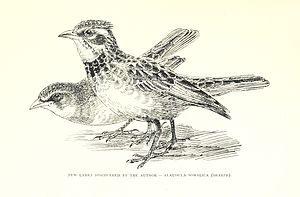Somali people
| Somali people | ||||||||||||
|---|---|---|---|---|---|---|---|---|---|---|---|---|

Representation of a couple of Somali lilies |
||||||||||||
| Systematics | ||||||||||||
|
||||||||||||
| Scientific name | ||||||||||||
| Calandrella somalica | ||||||||||||
| ( Sharpe , 1895) |
The Somali Lark ( Calandrella somalica ) is a species from the lark family. It corresponds in their body proportions of occurring among others in southern Europe toed Lark . The range of the Somali Lech is in the east of Africa. There are three subspecies.
The assignment of the Somali sheep to the genus Calandrella is currently being revised. In 2013, Per Alström and colleagues found in a study on the relationship of the larks that the genus Calandrella would be paraphyletic in the usual delimitation . According to their results, Calandrella consists of two groups of species. For those that do not contain the type species Calandrella brachydactyla , they reactivated the old genus name Alaudala Horsfield & Moore, which was previously considered a synonym , in 1856 (type species: Calandrella raytal ). Accordingly, the Somali lark should be transferred to this genus together with the Stummelche, the Tschililerche and the bank lark . This change has already been adopted in many cases. However, a more recent study from 2016 found an unstable phylogeny and raised doubts about the monophyly of some species.
Characteristics of the individual subspecies and their respective distribution area
The Somali lilies reach a body length of about 13 to 14 centimeters, of which between 4.3 and 5.0 centimeters are on the tail. It is one of the smallest larks. The beak measures between 1.3 and 1.5 centimeters from the skull. There is no gender dimorphism .
The Somali lark is similar in appearance to the Stummelche and has long been classified as a subspecies of it. Basically, the Somali Lech has comparatively short and wide wings with a rounded tip. There is an indistinct stripe above the eye, the chin and throat are whitish. The front breast is darkly dashed.
A total of three subspecies are distinguished:
- C. s. perconfusa - ( White , 1960) : Occurrence in the central area and in the western highlands of Northern Somalia . In this subspecies, the crown and the top of the body including the upper wing-coverts and shoulders are dark brown with broad sand-colored edges. The eye ring and the over-eye stripe are whitish to yellow-brownish. The cheeks and the ear covers are brown. A dark line runs along the sides of the neck. The chest is light brown with dark stripes that combine to form dark spots in individual individuals on the upper chest sides. The rest of the underside of the body is whitish with variable yellow-brown stripes.
- C. s. somalica - Sharpe , 1895 : The nominate form occurs from northern Somalia to eastern Ethiopia. With her, the feathers on the upper side of the body, on the wings and on the tail are bright wine-red. The underside of the body is light reddish with dark stripes on the chest.
- C. s. megaensis - ( Benson , 1946) : Breeds from southern Ethiopia to western Kenya. This subspecies has a more strongly striped top of the body than A. s. perconfusa . The individual feathers are lined with reddish color, the chest and the flanks are washed-out reddish brown and darkly dashed.
Way of life
The Somali Lech is a resident bird in its entire range. It eats seeds and insects and pecks them even from low vegetation. Like all larks, it is a ground breeder.
literature
- Rudolf Pätzold : The larks of the world . Westarp Sciences, Magdeburg 1994, ISBN 3-89432-422-8 .
- Rudolf Pätzold: Compendium of Larks. All the larks on earth. Jan-Schimkat-Medienpublikation, Dresden 2003, ISBN 3-00-011219-7 .
Web links
Single receipts
- ^ Pätzold: Compendium of Larks . P. 278.
- ↑ Per Alström, Keith N. Barnes, Urban Olsson, F. Keith Barker, Paulette Bloomer, Aleem Ahmed Khan, Masood Ahmed Qureshi, Alban Guillaumet, Pierre-André Crochet, Peter G. Ryan (2013): Multilocus phylogeny of the avian family Alaudidae (larks) reveals complex morphological evolution, non-monophyletic genera and hidden species diversity. Molecular Phylogenetics and Evolution 69 (3): 1043-1056. doi : 10.1016 / j.ympev.2013.06.005
- ↑ George Sangster, J. Martin Collinson, Pierre-André Crochet, Guy M. Kirwan, Alan G. Knox, David T. Parkin, Stephen C. Votier (2014): Taxonomic recommendations for Western Palaearctic birds: 10th report. Ibis 157: 193-200. doi : 10.1111 / ibi.12221
- ↑ Martin Stervander, Per Alström, Urban Olsson, Ulf Ottosson, Bengt Hansson, Staffan Bensch (2016): Multiple instances of paraphyletic species and cryptic taxa revealed by mitochondrial and nuclear RAD data for Calandrella larks (Aves: Alaudidae). Molecular Phylogenetics and Evolution 102: 233-245. doi : 10.1016 / j.ympev.2016.05.032
- ^ IOC World Bird List 6.4 . In: IOC World Bird List Datasets . September. doi : 10.14344 / ioc.ml.6.4 .
- ^ Pätzold: Compendium of Larks . P. 280.
